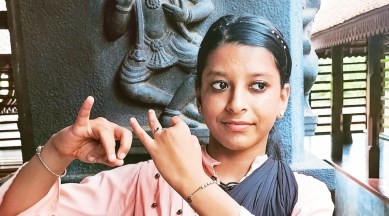Stay updated with the latest - Click here to follow us on Instagram
Madrasa to Kathakali school, how a 14-year-old chased her dreams
Sabri, who hails from Edamulackal village in Kollam district, formally joined the institute by offering guru dakshina to her teacher Kalamandalam Ravikumar.

Two years ago, a 12-year-old in a Kerala village sat in the darkness of a temple ground, surrounded by devotees, enchanted by a night-long Kathakali performance based on major episodes of the Ramayana.
Her fascination with the classical dance form continued – on June 19, Sabri N, 14, became the first Muslim girl to enrol in a Kathakali course at Kerala’s Kalamandalam, a 123-year-old institution at Cheruthuruthy in Thrissur district that’s one of the most prestigious centres for the performing arts. She is now a Class 8 student at the Kalamandalam Art Higher Secondary School and stays on the campus of the deemed-to-be university.
Sabri, who hails from Edamulackal village in Kollam district, formally joined the institute by offering guru dakshina to her teacher Kalamandalam Ravikumar.
monthly limit of free stories.
with an Express account.
Sitting at Koothambalam, the performance theatre at Kalamandalam, Sabri says she doesn’t think her faith has come in the way of her desire to learn Kathakali. “I believe in God. I used to wear a hijab like any other Muslim girl my age. In fact, I studied in a madrasa till Class 5. Thereafter, when Covid-19 struck, my mother began teaching me at home.”
Sabri’s presence in Kalamandalam has shattered several norms all at once. Kathakali was until recently a largely male preserve, with men even performing female roles. While women have started making a mark in this male-dominated bastion, it was only in 2021 that Kalamandalam’s residential Kathakali course opened up to girls. At a time of polarising debates and heightened identity politics, in Kerala and beyond, a Muslim girl in hijab entering an institution largely identified with traditional Hindu traditional art forms, is striking.
Of the two streams in Kathakali, thekkan (southern) and vaddakan (northern), Sabri has chosen to learn the southern style that’s focused on rasabhinayam, which involves stylised facial gestures. At the end of an eight-year training period, Sabri hopes to be a full-fledged Kathakali dancer. But she has a more immediate goal: performing the Krishna vesham.
“My dream is to stage the Krishna vesham. I like its mudras and gestures, apart from the colourful costumes,” she says.
“I have my family’s wholehearted support in learning Kathakali. I will follow the system, practice and uniform of the institute,” she adds, draping her dupatta over her head.
Sabri’s guru and head of the Thekkan Kathakali department, Kalamandalam Ravikumar, described her decision to join Kathakali as “revolutionary”. “Sabri is the first Muslim girl to join the Kathakali course. In the past, we have had a few Muslim students for other courses, but never for Kathakali. Of the seven students who joined southern-style Kathakali in Class 8 this year, four are girls,’’ he said.
The institute offers residential training in various classical dance forms, Carnatic music and traditional instruments with the 270-odd students being admitted to courses from Class 8 to post-graduation. The institute also offers MPhil and PhD programmes in performing arts and culture studies.
Recalling how his daughter took an interest in Kathakali, Sabri’s father Nizam S, a photographer who runs a studio in their village Edamulackal, said, “I would go to the Mahadeva temple at Agasthyacodu near our village to shoot the annual Shivratri festival in March. I would come back and show my daughter some of the Kathakali photographs I had captured. Two years ago, Sabri insisted on coming with me for the festival. I tried to dissuade her since Kathakali is played overnight. But she insisted on coming.”
Nizam was taken by surprise when Sabri sat through the night-long performance. This marked the beginning of Sabri’s interest in Kathakali.
Sabri then began training with Aromal, a Kathakali teacher who lived 25 km away from their village. An alumnus of Kalamandalam, Aromal worked as a temporary Kathakali teacher at the institute. On Sundays, Nizam would take Sabri to Aromal, who taught her the basic mudras of Kathakali. Nizam also took Sabri to Kalamandalam to familiarise her with the institution.
Nizam says that while his daughter’s choice of art form is unconventional, he has not faced any opposition from the Muslim community. “We are religious people and staunch believers of our faith. My daughter is also a practising Muslim. However, we do not follow anything blindly. If she wants to learn Kathakali, we will ensure that her dream is realised,’’ he said.
Sabri, he says, has been adhering to all the rules of the institution and participating in all its activities. “Like all other students, she offered a dakshina to the guru, a Hindu tradition. The teacher did not ask the students to pray to a Hindu God; instead, all of them were told to pray to a god of their choice,’’ said Nizam, whose wife Aneesha is a homemaker and eldest son Muhammed Yazeen, a class 12 student.